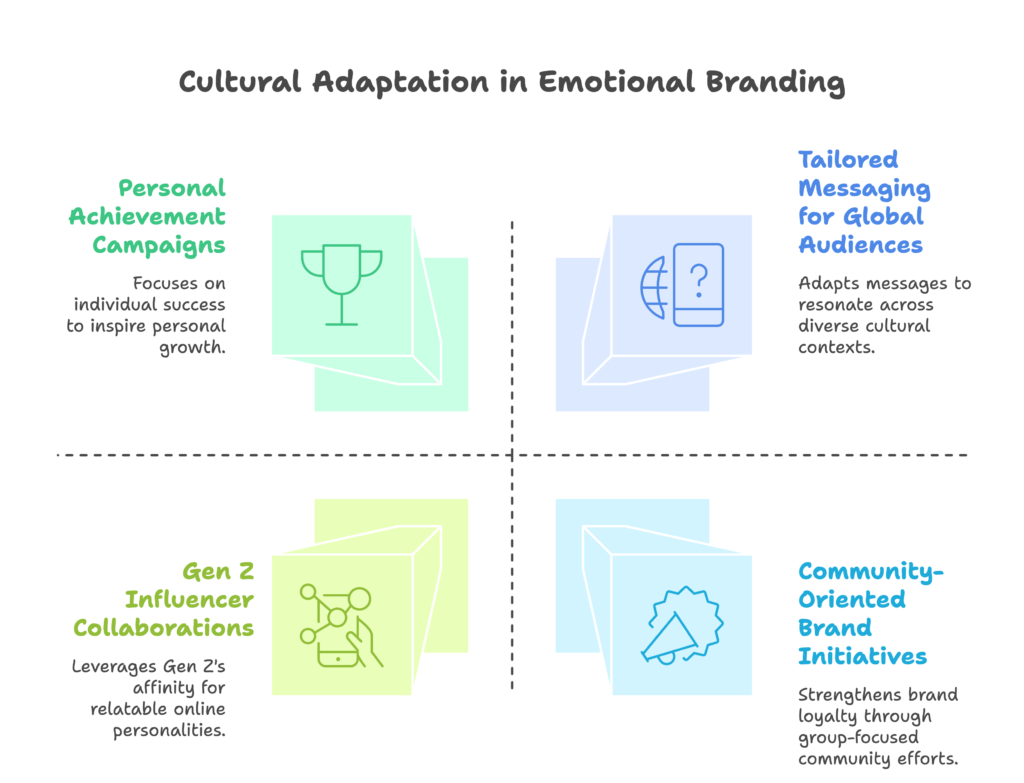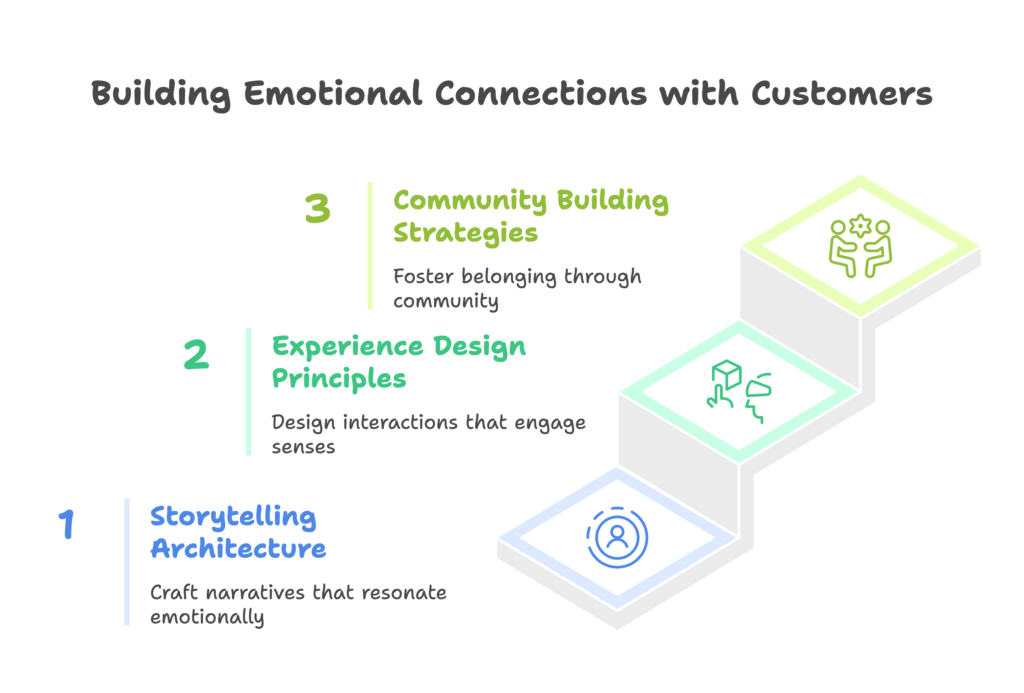Have you ever wondered why you feel so strongly about certain brands? Why the sight of that coffee shop logo makes you smile, or why you’ll drive an extra mile just to shop at your favorite store? It’s not magic—it’s emotional branding at work.
In a world where consumers are bombarded with thousands of marketing messages daily, creating a genuine emotional connection is no longer optional—it’s essential for survival. The brands that thrive today aren’t just selling products; they’re selling feelings, experiences, and identities.
By reading this article, you’ll discover:
- How your brain actually processes brand emotions (and why it matters)
- Proven principles for building emotional connections with customers
- Practical strategies to implement emotional branding in your business
- How to measure the impact of your emotional branding efforts
- Real-world case studies of brands that have mastered emotional connections
Ready to transform your customers into passionate brand advocates? Let’s dive in!
The Neuroscience of Emotional Branding
Before we jump into tactics, let’s understand what’s happening in your customers’ brains when they interact with your brand. This knowledge forms the foundation for all successful emotional branding strategies.
Neural Basis of Brand Emotions
When customers engage with brands they love, specific brain regions light up like a Christmas tree. The amygdala, your brain’s emotional processing center, activates when forming memories tied to emotional experiences with brands. That’s why you remember how you felt using a product long after you’ve forgotten its features.
Meanwhile, positive brand interactions trigger dopamine release—the same “feel-good” chemical that activates during pleasurable activities. This creates a reward system where customers begin to associate your brand with positive feelings.
Perhaps most interesting is oxytocin, often called the “trust hormone.” When brands tell authentic stories that resonate with consumers, oxytocin levels rise, fostering trust and loyalty. This explains why customers develop such strong bonds with brands that consistently deliver meaningful experiences.
Cognitive Processing of Brand Experiences
Your prefrontal cortex—the rational decision-making part of your brain—works overtime after emotional purchases to justify why you bought something. This is why emotional branding is so powerful; it creates the feeling first, then your brain works to rationalize the decision.
The hippocampus plays a crucial role in storing brand narratives in long-term memory. When brands create compelling stories, they’re actually helping customers encode these memories more deeply.
Additionally, the mirror neuron system activates when we see others experiencing emotions—which is why testimonials and user stories are so effective. When you see someone enjoying a product, your brain simulates that same enjoyment.
Evolutionary Drivers
Our brains evolved to quickly recognize patterns for survival, which explains why we develop emotional shortcuts when evaluating brands. Recognizing a trusted logo creates an immediate emotional response because your brain has cataloged previous experiences.
We’re also wired for social connection. Brand communities tap into our inherent need to belong to tribes and social groups. When customers identify with a brand community, powerful social bonding mechanisms activate.
Finally, symbolic consumption—buying products that represent our values and identity—is reinforced culturally. We’re taught from childhood to express ourselves through our choices, making brand selection an act of self-expression.
Now that you understand the brain science behind emotional connections, aren’t you curious about how to apply these insights practically? Let’s explore the core principles that make emotional branding work!
Core Principles of Emotional Branding
With a solid understanding of the neuroscience, we can now examine the foundational principles that guide successful emotional branding strategies. These frameworks will help you build stronger connections with your audience.

Marc Gobé’s Ten Commandments
Marketing visionary Marc Gobé revolutionized branding with his “Ten Commandments of Emotional Branding.” Three key principles stand out:
From Consumer to People: Traditional marketing treats people as consumers—numbers on a spreadsheet. Emotional branding sees them as humans with complex needs, desires, and emotions. This shift means talking with your customers, not at them.
From Product to Experience: Products are replaceable; experiences are memorable. Instead of focusing solely on what your product does, create meaningful interactions at every touchpoint. Think about how Apple transforms a simple purchase into an event, complete with beautiful packaging and a thoughtfully designed unboxing experience.
From Honesty to Trust: Honesty is expected and basic. Trust is earned and valuable. Emotional branding builds trust by consistently delivering on promises and admitting mistakes when they happen. This authenticity becomes a valuable currency in customer relationships.
Four Pillars Framework
Successful emotional branding stands on four essential pillars:
Trust: Earned through consistent delivery of your brand promises. When customers know they can count on you, emotional bonds strengthen. Trust is built through reliability and transparency, but can be lost in an instant if broken.
Lifestyle: Strong brands align with how customers see themselves—or how they want to see themselves. Your brand should reflect the lifestyle your target audience aspires to live. When customers feel your brand understands their identity, loyalty follows naturally.
Personality: Just like people, brands need distinct character traits that make them recognizable and relatable. Is your brand playful or serious? Innovative or traditional? Developing a consistent personality helps customers form emotional attachments.
Relationship: Emotional branding creates an ongoing dialogue with customers. This relationship evolves over time through consistent interactions that strengthen the emotional connection. Think about how your brand can foster two-way communication.
Cultural Adaptation Matrix
Emotions aren’t universal—they’re deeply influenced by cultural context. Effective emotional branding considers these cultural differences:
Individualist vs. Collectivist Triggers: Western cultures often respond to messages about personal achievement and standing out, while collectivist cultures value harmony and group belonging. Your emotional appeals should align with your audience’s cultural values.
Generational Values: Each generation has unique experiences shaping their emotional responses. Baby Boomers, Gen X, Millennials, and Gen Z all respond differently to emotional triggers. Tailoring your messaging to generational values strengthens connections.
Multicultural Sensitivity: In our global marketplace, emotions can be easily misinterpreted across cultural boundaries. Successful emotional branding requires sensitivity to diverse perspectives and careful consideration of how messages might be received in different contexts.
These principles form a solid foundation, but how do you put them into action? Let’s explore practical strategies for implementing emotional branding in your business!
Strategic Implementation Framework
Understanding principles is important, but applying them makes all the difference. Let’s look at specific strategies to build emotional connections with your customers.

Storytelling Architecture
Stories are the most powerful tool in your emotional branding arsenal. They bypass rational defenses and speak directly to emotions. Effective brand storytelling includes:
Hero’s Journey Narratives: Structure your brand stories following the classic hero’s journey, where your customer is the hero facing a challenge, and your brand helps them overcome it. This framework resonates deeply because it mirrors how humans naturally process experiences.
Multisensory Brand Mythology: Create rich brand stories that engage multiple senses. Consider how your story can be expressed visually, through sound, and even through physical sensations. The more senses you engage, the stronger the emotional imprint.
Cross-Platform Continuity: Your story should maintain consistency across all platforms while adapting to each medium’s strengths. Whether customers encounter your brand on Instagram, your website, or in-store, the emotional narrative should feel cohesive yet native to each platform.
Experience Design Principles
Every interaction with your brand is an opportunity to strengthen emotional connections:
Sensory Branding Touchpoints: Consider how your brand engages all senses. The distinctive sound when opening a can of Pringles, the unique smell when walking into a Starbucks, or the satisfying tactile experience of unboxing an iPhone—all create powerful emotional memories.
Ritual Creation: Develop brand rituals that customers can incorporate into their lives. Think about how Corona encourages adding a lime wedge, turning a simple act into a meaningful ritual that distinguishes the brand experience.
Surprise and Delight Mechanics: Unexpected positive experiences create disproportionately strong emotional responses. Map your customer journey to identify opportunities for surprising moments that exceed expectations—like Zappos occasionally upgrading shipping without charge.
Community Building Strategies
Humans crave belonging. Building brand communities creates powerful emotional bonds:
User-Generated Content Ecosystems: Encourage customers to create and share content related to your brand. This not only provides authentic marketing material but also gives customers a sense of ownership in your brand story.
Brand Advocacy Reward Systems: Recognize and reward your most passionate customers. Programs that acknowledge loyalty create reciprocal emotional connections and encourage continued advocacy.
Shared Value Initiatives: Support causes your customers care about. When brands champion social or environmental causes, customers feel good about supporting businesses aligned with their values. TOMS Shoes pioneered this approach with their one-for-one donation model.
These strategies sound great, but how do you know if they’re actually working? Let’s look at how to measure the impact of your emotional branding efforts!
Measurement & Optimization
Emotional connections may seem abstract, but their impact can be measured. The right metrics help you understand what’s working and where to improve.
Neurometric Tracking
Advanced technology now allows brands to measure emotional responses directly:
EEG Emotional Engagement: Electroencephalography (EEG) measures brain activity to assess emotional engagement with advertising or brand experiences. While complex, these tools provide objective data about emotional responses that subjects might not even be consciously aware of.
Facial Coding Analysis: Software can now analyze micro-expressions—brief, involuntary facial movements that reveal true emotions. This technology helps brands understand emotional reactions to specific touchpoints or messaging.
Biometric Wearables: Devices tracking heart rate, skin conductance, and other physiological markers help brands understand real-world emotional responses to experiences. This data provides insights into how customers really feel, not just what they say they feel.
Behavioral Metrics
Customer actions reveal emotional connections in meaningful ways:
Emotional Connection Score (ECS): This composite metric combines survey data with behavioral indicators to measure emotional attachment. Higher scores correlate with increased customer lifetime value and brand loyalty.
Net Emotional Value (NEV): Similar to Net Promoter Score, NEV measures the balance of positive versus negative emotions associated with your brand. This simple metric helps track emotional brand health over time.
Content Sharing Rates: When customers share your content, it indicates an emotional connection strong enough to associate themselves publicly with your brand. Tracking sharing behavior provides insights into emotional resonance.
Cultural Impact Assessment
Understanding your brand’s emotional impact across different contexts:
Cross-Market Resonance: Analyze how your emotional branding performs across different markets and cultural contexts. This helps identify whether your emotional approach translates well or needs cultural adaptation.
Generational Sentiment Tracking: Monitor how different age groups emotionally respond to your brand. This helps ensure your emotional branding remains relevant as your customer base evolves.
Crisis Response Recovery: Measure how quickly emotional sentiment recovers after brand challenges or crises. Emotionally connected customers are more forgiving when brands make mistakes, making this an important indicator of brand resilience.
Measuring emotions is powerful, but it also raises important ethical questions. How do we ensure emotional branding respects customers and builds authentic relationships? Let’s explore the ethical dimensions next.
Ethical Implementation Guidelines
With great power comes great responsibility. Emotional branding influences people deeply, so ethical considerations are essential.
Authenticity Standards
Authentic emotional connections must be built on truth:
Promise-Reality Alignment: Regularly audit how well your actual customer experience matches what your brand promises. Emotional disappointment when expectations aren’t met causes lasting damage to brand relationships.
Vulnerability Protection: Emotional branding creates vulnerability, especially for certain audiences. Develop protocols to ensure you’re not exploiting emotional needs, particularly for sensitive demographics or during difficult times.
Cultural Appropriation Prevention: Before adopting cultural elements in your emotional branding, ensure you’re honoring rather than appropriating cultural significance. Consult with cultural representatives and approach with respect and understanding.
Neuroethical Considerations
As neuromarketing advances, new ethical questions emerge:
Emotional Manipulation Boundaries: Set clear internal guidelines about what constitutes acceptable emotional influence versus manipulation. Creating positive emotions around your brand is appropriate; exploiting fears or insecurities often isn’t.
Biometric Data Consent: If collecting physiological or neurological data, ensure transparent consent processes. Customers should understand what data you’re collecting and how it will be used.
Cognitive Liberty: Respect customers’ right to make informed decisions. Emotional branding should enhance, not override, rational choice. Provide transparent information alongside emotional appeals.
Sustainable Emotional Relationships
Long-term emotional connections require sustainable practices:
Brand Health Monitoring: Track indicators of healthy versus unhealthy emotional connections. Obsessive brand attachment may benefit short-term sales but can damage long-term brand perception.
Emotional Fatigue Prevention: Even positive emotions can cause fatigue if overused. Vary your emotional approach to prevent burnout, especially with frequently purchased products or services.
Value-Driven Co-Creation: Involve customers in developing your brand. This collaborative approach ensures your emotional branding evolves in ways that continue to resonate authentically.
Ethics provide the foundation for sustainable emotional branding. But what does successful emotional branding look like in practice? Let’s examine some real-world examples!
Case Studies in Emotional Branding
Theory becomes powerful when we see it applied successfully. These brands have mastered the art of emotional connection.
Apple’s Ecosystem Bonding
Apple has created perhaps the strongest emotional brand connection in the modern era through two key strategies:
Seamless Experience as Emotional Glue: Apple products work together so effortlessly that switching to another brand feels like losing something valuable. This ecosystem creates a powerful emotional bond that transcends individual products.
“Think Different” Cultural Alignment: By positioning its brand as a symbol of creativity and innovation, Apple connected with customers’ desire to see themselves as forward-thinking individuals. This identity-based emotional connection transformed customers into passionate advocates.
The result? Apple customers don’t just use products; they form emotional relationships with them. The grief some people feel when their iPhone breaks reveals the depth of this connection—it’s not just a phone, it’s part of their identity.
Patagonia’s Activist Branding
Patagonia has built emotional connections through value alignment and surprising authenticity:
Environmental Stewardship Leverage: By championing environmental causes, Patagonia connects with customers who share these values. This emotional bond based on shared purpose creates loyalty that transcends product features or price.
“Don’t Buy This Jacket” Paradox: In a bold move, Patagonia once ran an ad asking customers not to buy a new jacket unless they truly needed it. This counter-intuitive approach demonstrated authentic commitment to sustainability over profit, deepening emotional connections with value-aligned customers.
Patagonia proves that emotional branding based on shared values creates customers willing to pay premium prices while becoming brand evangelists.
Nike’s Empowerment Narrative
Nike has mastered emotional storytelling that resonates across diverse audiences:
“Just Do It” Personal Triumph Framing: Nike’s iconic slogan taps into universal emotional territory—the struggle to overcome personal limitations. By positioning their products as tools for self-improvement, Nike creates emotional connections that transcend sports.
Social Justice Alignment: Nike’s decision to feature Colin Kaepernick in their campaign showed how emotional branding sometimes requires taking stands that might alienate some customers but deeply strengthen connections with others. The campaign generated initial controversy but ultimately strengthened Nike’s emotional bond with their core audience.
Nike demonstrates that emotional branding rooted in empowerment creates lasting connections that weather changing trends and occasional controversies.
These case studies show emotional branding in action today, but what’s coming tomorrow? Let’s peek into the future of emotional connections between brands and customers.
Future of Emotional Branding
The landscape of emotional branding continues to evolve with new technologies and understandings. Here’s what’s on the horizon.
Emerging Technologies
New tools are transforming how brands create emotional connections:
AI-Powered Emotional Personalization: Artificial intelligence will soon analyze individual emotional responses to deliver personalized experiences that resonate on a deeper level. Imagine content that automatically adjusts to match your current emotional state.
VR/AR Immersive Experiences: Virtual and augmented reality technologies create opportunities for immersive brand experiences that generate powerful emotional responses. These technologies will allow brands to create memorable moments that were previously impossible.
Blockchain-Verified Authenticity: As consumers increasingly value authenticity, blockchain technology will enable brands to verify ethical claims and origin stories, strengthening emotional trust in an era of skepticism.
Predictive Systems
The future of emotional branding will increasingly focus on anticipation:
Emotional Lifetime Value Forecasting: Advanced models will predict the long-term emotional connection potential of different customer segments, allowing brands to invest strategically in relationships with the highest emotional potential.
Cultural Shift Anticipation: Sophisticated systems will help brands detect early signs of cultural value shifts, allowing proactive adaptation of emotional branding strategies before competitors.
Real-Time Sentiment Adaptation: Technologies enabling brands to adjust messaging in real-time based on emotional feedback will become mainstream, creating more responsive and emotionally attuned brand communications.
Theoretical Advancements
Our understanding of emotional connections continues to deepen:
Quantum Emotional Resonance: Emerging models suggest emotional connections might function similar to quantum entanglement—once established, they influence each other across distance and time. This evolving understanding may transform how we conceptualize brand relationships.
Cross-Species Branding Insights: Research into how animals form emotional attachments is providing surprising insights applicable to human brand relationships. These biological perspectives offer new frameworks for understanding loyalty.
Neuroethical Framework Evolution: As emotional branding becomes more sophisticated, ethical frameworks will evolve to address new questions about influence, consent, and emotional well-being in brand relationships.
The future of emotional branding offers exciting possibilities for creating more meaningful, authentic connections. Brands that stay ahead of these trends will build lasting relationships that weather changing markets.
Remember: Shopify store owners can leverage these emotional branding strategies with the help of Growth Suite. This powerful application helps you implement personalized experiences, track emotional engagement metrics, and build stronger customer connections—all leading to increased sales and loyalty.
References
- Gobé, M. (2001). Emotional Branding. [Book] Cited in Wikipedia (2025). https://en.wikipedia.org/wiki/Emotional_branding
- Proweaver (2025). Emotional Connections in Branding. https://www.proweaver.com/emotional-connections-in-branding
- LinkedIn (2025). Neuromarketing in Emotional Branding. https://www.linkedin.com/pulse/emotional-branding-how-neuromarketing-helps-brands-connect-maithra-ybdvc
- Forbes (2021). Emotional Marketing Examples. https://www.forbes.com/councils/forbescommunicationscouncil/2021/11/15/15-effective-examples-of-emotional-marketing-brands-can-learn-from/
- HKR Research Portal (N/A). Emotional Branding Factors. https://researchportal.hkr.se/files/35087588/FULLTEXT01.pdf
- Highly.Digital (2023). Emotional Marketing Metrics. https://highly.digital/digital-marketing/key-metrics-for-emotional-marketing-success/
- Neuroscience Marketing (2024). Emotional Branding Principles. https://www.neurosciencemarketing.com/blog/articles/emotional-branding.htm




